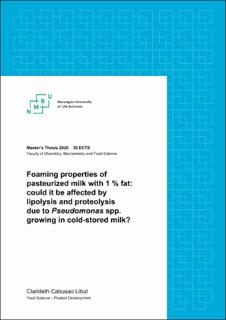| dc.description.abstract | A velvety, shiny, and compact foam with fine bubbles is desirable in the coffee shop industry to produce coffee drinks like cappuccino or café latte. However, baristas in the cafés are not always able to create this desirable steam-frothed milk foam.
The main objective of this study is to investigate whether the selected strains of Pseudomonas spp. showing diverse lipolytic and proteolytic capabilities affect the foaming properties of refrigerated semi-skimmed milk with 1 % fat. This study measured the extent of lipolysis and proteolysis in terms of free fatty acid concentration and casein degradation in pasteurized milk with 1 % fat.
The slight casein degradation in the two milk samples did not show a significant effect on the foaming properties. However, not all the casein degradation in the milk were visible in the electropherograms. Therefore, the effect of bacterial proteases on the foaming properties could not be eliminated. On the other hand, the significant amount of FFA liberated by the Pseudomonas strain with the highest lipolytic capability showed a direct correlation with the impaired foaming properties of the milk. Challenges in forming a foam suitable for latte art could be affected by poor microbiological quality. Although psychrotrophic bacteria, which predominate in raw milk, are eliminated during pasteurization, the heat-stable extracellular lipases and proteinases produced by the bacteria, specifically Pseudomonas spp., survive the heat-treatment and could remain active in refrigerated milk and continuously degrade the fat and proteins in the milk. It is therefore important to develop a more efficient control measures to limit the contamination of the milk. Since Pseudomonas spp. thrive in cold temperatures and lipolysis could occur even at cold storage, good hygiene practices should be improved in every step in the supply chain in order to reduce the contamination. | en_US |

